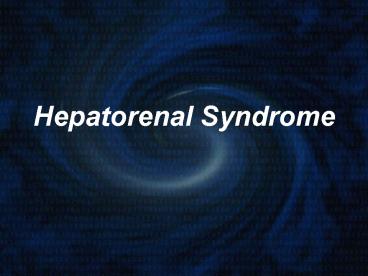Hepatorenal Syndrome - PowerPoint PPT Presentation
1 / 12
Title:
Hepatorenal Syndrome
Description:
Activation of endogenous vasoactive systems. ... Predisposing factors include hypovolemic or septic shock, or exposure to nephrotoxic drugs. ... – PowerPoint PPT presentation
Number of Views:2570
Avg rating:3.0/5.0
Title: Hepatorenal Syndrome
1
Hepatorenal Syndrome
2
DEFINITION Hepatorenal syndrome is a clinical
condition that usually occurs in patients with
advanced liver disease and portal hypertension
that is characterized by -Renal failure, with
creatinine level more than 1.5mg/dl -Marked
decrease in GFR and renal plasma flow (RPF) in
the absence of other identifiable cause of renal
failure. -Marked abnormality in systemic
hemodynamics -Activation of endogenous vasoactive
systems. HRS occurs predominantly in the setting
of cirrhosis, but it may also develop in other
types of severe chronic liver diseases, such as
alcoholic hepatitis, or in acute liver failure.
3
- PATHOGENESIS
- Factors involved in the pathogenesis of HRS are
- Disturbance in systemic hemodynamics (VD mainly
splanchnic) - Increased activity of vasoconstrictor systems
- Reduced activity of vasodilator factors
- Vasodilators
vasoconstrictors - Prostaglandins
RAAS and SNS - Nitric oxide
ADH , Endothelin
- Atrial natriuritic peptide
Adenosine, leukotrienes
4
The theory that best fits with the observed
alterations in the renal and circulatory function
in HRS is the arterial vasodilation theory, which
proposes that HRS is the result of the effect of
vasoconstrictor systems acting on the renal
circulation and activated as a homeostatic
mechanisms to improve the extreme underfilling of
the arterial circulation. That leads to decreased
renal perfusion and glomerular filtration rate
(GFR) but tubular function is preserved.
5
6
- There are two well-differentiated clinical
patterns of HRS - Type 1 HRS
- Characterized by rapid and progressive impairment
of renal function defined as a doubling of the
initial serum creatinine to a level greater than
2.5 mg/dl or a 50 reduction of the initial
24-hour creatinine clearance to a level lower
than 20 ml/min in less than 2 weeks. - Usually occur in severe liver failure (Jaundice,
encephalopathy, and coagulopathy) - Occur frequently after precipitating factor (e.g.
GI bleeding) - Median survival time is only 2 weeks
7
- Type 2 HRS
- Characterized by a less severe and
non-progressive reduction of GFR. - Associated with relatively preserved liver
function. - The main clinical consequence of this type of HRS
is refractory ascites, due to a lack of response
to diuretics. - Median survival time is about 6 months.
8
- The International Ascites Club has defined
criteria for the - diagnosis of HRS. Major criteria, necessary only
for the - diagnosis, are as follows
- Low GFR, defined by a serum creatinine greater
than 1.5 mg/dL or 24-hour clearance lower than 40
mL/min - Absence of shock, ongoing bacterial infection,
fluid losses and current treatment with
nephrotoxic drugs - No sustained improvement in renal function
(decrease in serum creatinine to lt1.5 mg/dL or
increase in clearance to gt40 mL/min) following
diuretic withdrawal and plasma volume expansion
with albumin (or 1.5 L of isotonic saline). - Proteinuria less than 500 mg/d
- Absence of any evidence of obstructive uropathy
or parenchymal disease as shown by ultrasonography
9
- Additional criteria
- Urine volume lower than 500 mL/d
- Urine sodium less than 10 mEq/L
- Urine osmolality greater than the plasma
osmolality - Urine blood cells fewer than 50 per high-power
field - Serum sodium concentration lower than 130 mEq/L
10
- Other causes of renal failure in patients with
liver cirrhosis - Drug-induced renal failure( e.g. aminoglycosides
and NSAIDs) - Glomerulonephritis
- Prerenal failure
- Sepsis
- Acute tubular necrosis
11
- Acute tubular necrosis is characterized by
- Abrupt impairment in function.
- Predisposing factors include hypovolemic or
septic shock, or exposure to nephrotoxic drugs. - The following criteria may be useful for
diagnosis - ?urine sodium conc.
- Urine/serum osmolarity
ratiolt1 - Abnormal urine
sediment - Glomerular disease
- Seems to be independent of etiology of cirrhosis
- May be protinuria /or hematuria
- Drug induced RF
- Aminoglycosides NSAIDs are most common.
- C/P ATN.
- Prerenal azotemia
- Due to intravascular vol. depletion (causes
vomiting diarrhea diuretic overuse- shock) - Unlike HRS, prerenal azotemia improve after
plasma volume expansion with 1.5L of isotonic
saline.
12
THANK YOU M SEIF































